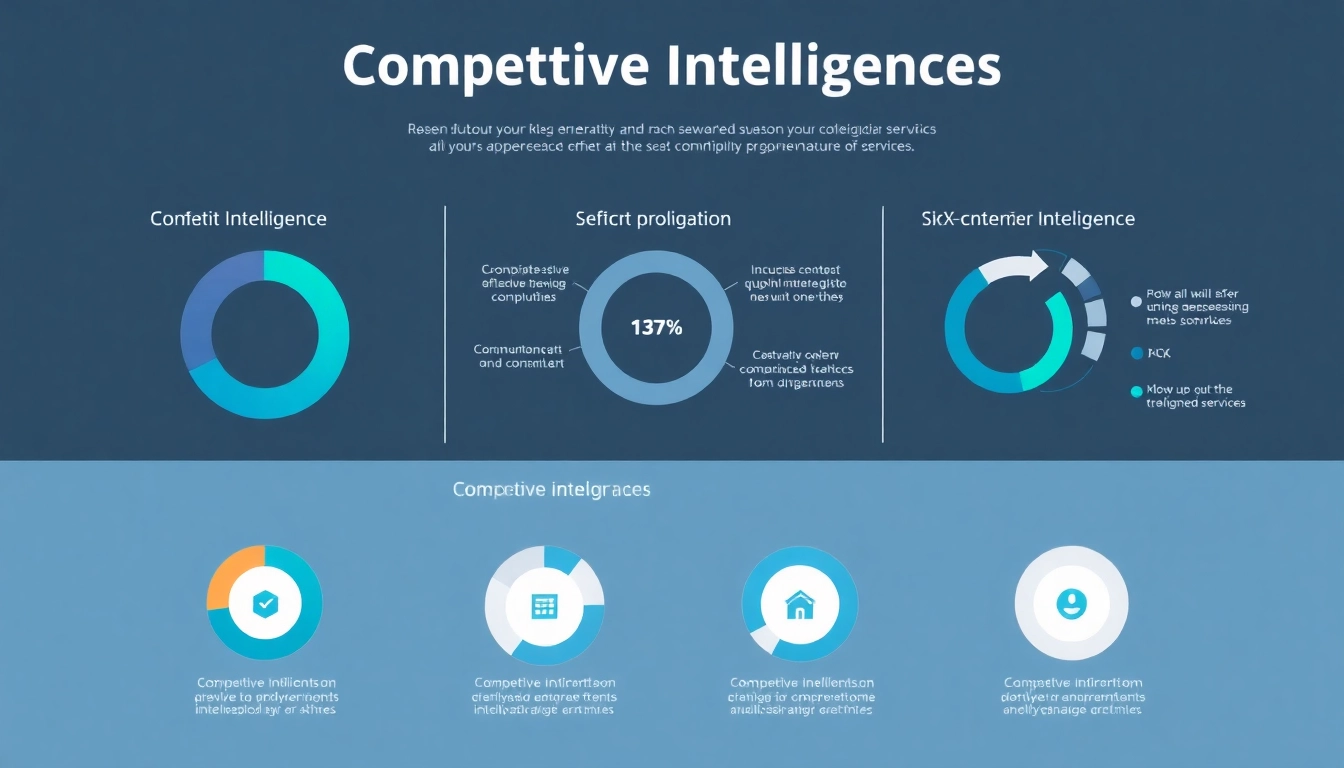Maximizing Business Growth with Competitive Intelligence Services
Understanding Competitive Intelligence Services
In today’s rapidly evolving business landscape, the ability to leverage competitive intelligence services is paramount for organizations striving to maintain a competitive edge. Competitive intelligence (CI) encompasses a systematic approach to gathering, analyzing, and disseminating information related to competitors, market trends, and customer preferences. Understanding and utilizing these services effectively can provide significant advantages for businesses across various industries.
Definition and Importance
Competitive intelligence refers to the activity of collecting and analyzing information about the external environment in which a company operates. This includes insights about competitors, market dynamics, and broader industry trends. The importance of competitive intelligence lies in its capability to inform strategic decision-making, enabling companies to anticipate market shifts, mitigate risks, and capitalize on opportunities before their rivals can.
The value of CI cannot be overstated; it is crucial for organizations aiming to improve their market position and drive innovation. Companies that effectively utilize CI can respond to competitive threats proactively rather than reactively, thus establishing themselves as industry leaders rather than followers.
Key Components of Competitive Intelligence
Successful competitive intelligence services encompass several key components, including:
1. Data Gathering: This initial step involves collecting raw data from various sources, such as market research reports, competitor websites, news articles, and social media. Effective CI services leverage a mix of primary (first-hand data collection) and secondary research (aggregated and published data).
2. Data Analysis: Once the data is gathered, it must be analyzed for meaningful insights. This process involves identifying patterns, trends, and correlations that can provide actionable intelligence.
3. Dissemination of Information: Sharing insights across the organization is as crucial as gathering and analyzing data. CI must be communicated effectively to stakeholders, from executives to sales teams, ensuring that the intelligence impacts decision-making processes.
4. Monitoring and Updating: The competitive landscape is not static; ongoing monitoring is critical to adapting strategies based on new information. CI services should include processes for continuous updates and analysis to keep pace with market changes.
How CI Services Benefit Businesses
The advantages of implementing competitive intelligence services are manifold:
– Enhanced Strategic Planning: CI provides businesses with the information necessary to make informed strategic decisions. This includes market entry strategies, product development, and resource allocation.
– Risk Mitigation: By understanding competitors’ strengths and weaknesses, companies can anticipate potential threats and develop strategies to mitigate these risks, thus safeguarding their market position.
– Innovation and Growth: CI can uncover market gaps and customer needs that competitors may overlook, fostering innovation and leading to new products and services.
– Improved Market Positioning: With detailed insights into competitor pricing, marketing strategies, and customer perception, companies can refine their own strategies to better align with market demands.
Types of Competitive Intelligence Services
There are several types of competitive intelligence services that organizations can utilize to enhance their strategic capabilities:
Market Research and Analysis
Market research focuses on understanding the broader environment in which a business operates, encompassing economic indicators, market demographics, industry trends, and consumer behavior. CI services often conduct comprehensive analyses that include thorough examinations of market share, market size, and growth forecasts.
Key activities in market research and analysis include:
– Surveys and Questionnaires: Collecting direct feedback from consumers to understand their preferences.
– Focus Groups: Engaging specific customer segments to gain deeper insights into their needs and perceptions.
– Competitive Analysis: Identifying key competitors and analyzing their market position, including their strengths, weaknesses, pricing strategies, and customer engagement tactics.
Competitor Analysis and Benchmarking
Competitor analysis involves a more focused approach, concentrating specifically on direct competitors. This type of CI service provides businesses with a detailed understanding of their competitive landscape. Key aspects include:
– SWOT Analysis: Identifying the strengths, weaknesses, opportunities, and threats of both the organization and its competitors.
– Benchmarking: Establishing performance metrics based on competitor data to assess where a company stands in relation to its peers.
– Competitor Product Reviews: Analyzing competitor products or services to identify unique selling propositions, gaps in the market, and potential areas for differentiation.
Customer Insights and Segmentation
Understanding customers is critical for effective competitive intelligence services. This includes gathering insights on customer preferences, behavior, and demographic segmentation. By categorizing customers, businesses can tailor their services and marketing efforts to meet the diverse needs of their target audience. Essential activities include:
– Customer Journey Mapping: Analyzing the steps a customer takes from awareness to the purchase decision.
– Customer Segmentation: Dividing the customer base into groups based on shared characteristics, allowing for targeted marketing approaches.
– Feedback Mechanisms: Implementing processes for ongoing customer feedback to stay attuned to changing preferences and emerging market trends.
Implementing Effective Competitive Intelligence Strategies
Implementing an effective competitive intelligence strategy requires careful planning and execution. Below are key steps organizations should consider:
Identifying Your Objectives
Before engaging in competitive intelligence, it is essential to define clear objectives. Organizations should ask themselves:
– What are the specific questions we need answers to?
– What decisions will this intelligence inform?
– Which competitors or market segments are most relevant to our strategy?
By establishing these objectives, businesses can streamline their CI efforts and ensure they are focused on areas that will yield the most actionable insights.
Choosing the Right Tools and Resources
Numerous tools are available to support competitive intelligence efforts, from data analytics software to market research agencies. The choice of tools should align with the organization’s objectives and available resources. Considerations include:
– Data Collection Tools: Platforms that aggregate data from various sources such as market reports, news articles, and social media.
– Analytical Software: Tools that help analyze collected data and visualize insights effectively.
– Consultancy Services: Engaging with professional CI firms can augment internal capabilities and provide expertise in data interpretation.
Establishing Continuous Monitoring
Competitive intelligence is an ongoing process rather than a one-time event. Companies should establish systems for continuous monitoring of both competitors and market changes. This can include:
– Regular SWOT Analyses: Conducting periodic reviews to update assumptions based on the latest data.
– News Alerts and Feeds: Setting up alerts for news related to competitors or industry shifts.
– Monthly Review Meetings: Establishing regular check-ins with key stakeholders to discuss significant CI findings and their implications for business strategy.
Challenges in Competitive Intelligence
While the benefits of competitive intelligence are significant, businesses may face various challenges in their implementation. Addressing these obstacles is critical for successful CI initiatives.
Data Accuracy and Reliability
One of the primary challenges in CI is ensuring the accuracy and reliability of collected data. With the vast amount of information available, distinguishing between credible sources and misinformation can be difficult. Companies can mitigate this risk by:
– Cross-Referencing Sources: Validating data against multiple credible sources to assess its reliability.
– Engaging with Experts: Consulting industry experts or professional CI firms can enhance the quality of insights.
– Establishing Standard Protocols: Developing procedures for data collection and analysis that emphasize accuracy and reliability.
Staying Within Legal Boundaries
Competitive intelligence must be conducted ethically and legally. Distinguishing between lawful CI practices and industrial espionage is crucial. Organizations should prioritize:
– Legal Compliance Training: Ensure that all personnel involved in CI are trained to understand legal constraints.
– Ethical Frameworks: Establish guidelines for ethical conduct in information gathering.
– Consulting Legal Experts: Involving legal counsel during the initial stages of CI planning can help identify potential pitfalls.
Adapting to Rapid Market Changes
The speed of market changes can pose a significant challenge to effective competitive intelligence. Businesses must remain agile and adapt their CI processes quickly in response to new developments. Strategies include:
– Flexibility in CI Plans: Building adaptability into CI strategies to allow for rapid shifts in focus based on emerging data.
– Encouraging a CI Culture: Fostering an organizational culture that values ongoing learning and adaptation can enhance CI responsiveness.
– Investing in Technology: Utilizing advanced analytics tools that can provide real-time insights can significantly improve reaction times to market changes.
Case Studies: Successful Applications of Competitive Intelligence
Real-world applications of competitive intelligence services underscore their effectiveness in driving organizational success. Below are notable case studies illustrating the impact of CI on various businesses.
Real-World Examples of CI Impact
1. Tech Industry: Company X, a software development firm, implemented a CI strategy to gain insights into competitor pricing models. By analyzing competitors’ offerings and customer feedback, they were able to identify a gap in service features and launched a competitive product that significantly increased their market share.
2. Retail Sector: A leading retail chain utilized CI to understand customer buying habits during seasonal sales. By segmenting their customer data, they optimized their marketing strategies, resulting in a 30% increase in sales during the holiday season.
3. Pharmaceutical Industry: A pharmaceutical company adopted CI to monitor competitor research and development initiatives. This approach allowed them to anticipate changes in regulatory conditions and adapt their product development accordingly, thereby ensuring compliance and maintaining their market position.
Analyzing Outcomes
The outcomes of successful CI implementations reflect the importance of aligning data-driven insights with strategic goals. Companies that have effectively harnessed CI have seen improvements in operational efficiency, market responsiveness, and overall financial performance.
– Market Growth: Organizations that employ CI are more likely to experience sustainable growth by addressing customer needs ahead of market trends.
– Cost Reduction: Effective CI practices can lead to cost savings by identifying inefficiencies and areas for process improvement.
– Increased ROI: Investments in CI tools and services often yield returns through enhanced strategic decision-making and improved customer engagement.
Lessons Learned and Best Practices
When implementing competitive intelligence, several lessons can be gleaned from organizations that have successfully navigated the process:
1. Start Small, Scale Up: New CI initiatives should begin with manageable projects that can be scaled over time as the organization gains confidence and expertise.
2. Involve Cross-Functional Teams: Engaging various departments, such as marketing, sales, and product development, ensures that insights are shared across the organization.
3. Regular Training and Development: Continuous education on industry trends and CI practices ensures that employees remain informed and equipped to leverage insights effectively.
4. Measure and Refine CI Processes: Establishing metrics for success allows organizations to continually refine their CI strategies based on performance outcomes.
Conclusion
In a competitive business environment, the role of competitive intelligence services is more crucial than ever. By understanding the fundamentals of CI, exploring various services, implementing effective strategies, and addressing potential challenges, businesses can position themselves for success. Through diligent application of CI practices, organizations not only enhance their strategic capabilities but also foster a culture of informed decision-making that can lead to sustained growth and innovation. Whether through market analysis or competitor benchmarking, the insights gained from competitive intelligence can serve as a vital tool in navigating the complexities of the marketplace and achieving long-term business objectives.








Post Comment